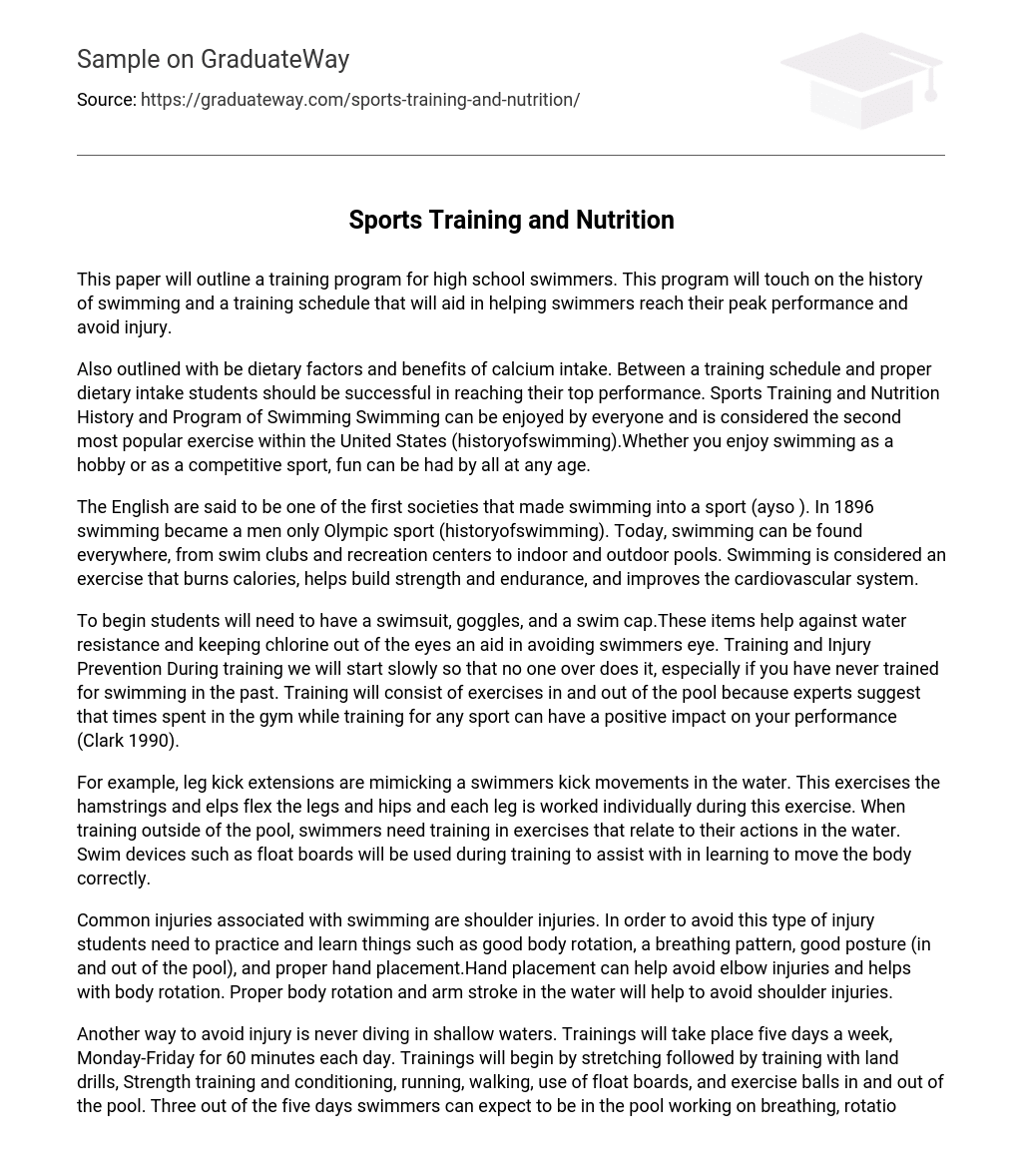This paper will outline a training program for high school swimmers. This program will touch on the history of swimming and a training schedule that will aid in helping swimmers reach their peak performance and avoid injury.
Also outlined with be dietary factors and benefits of calcium intake. Between a training schedule and proper dietary intake students should be successful in reaching their top performance. Sports Training and Nutrition History and Program of Swimming Swimming can be enjoyed by everyone and is considered the second most popular exercise within the United States (historyofswimming).Whether you enjoy swimming as a hobby or as a competitive sport, fun can be had by all at any age.
The English are said to be one of the first societies that made swimming into a sport (ayso ). In 1896 swimming became a men only Olympic sport (historyofswimming). Today, swimming can be found everywhere, from swim clubs and recreation centers to indoor and outdoor pools. Swimming is considered an exercise that burns calories, helps build strength and endurance, and improves the cardiovascular system.
To begin students will need to have a swimsuit, goggles, and a swim cap.These items help against water resistance and keeping chlorine out of the eyes an aid in avoiding swimmers eye. Training and Injury Prevention During training we will start slowly so that no one over does it, especially if you have never trained for swimming in the past. Training will consist of exercises in and out of the pool because experts suggest that times spent in the gym while training for any sport can have a positive impact on your performance (Clark 1990).
For example, leg kick extensions are mimicking a swimmers kick movements in the water. This exercises the hamstrings and elps flex the legs and hips and each leg is worked individually during this exercise. When training outside of the pool, swimmers need training in exercises that relate to their actions in the water. Swim devices such as float boards will be used during training to assist with in learning to move the body correctly.
Common injuries associated with swimming are shoulder injuries. In order to avoid this type of injury students need to practice and learn things such as good body rotation, a breathing pattern, good posture (in and out of the pool), and proper hand placement.Hand placement can help avoid elbow injuries and helps with body rotation. Proper body rotation and arm stroke in the water will help to avoid shoulder injuries.
Another way to avoid injury is never diving in shallow waters. Trainings will take place five days a week, Monday-Friday for 60 minutes each day. Trainings will begin by stretching followed by training with land drills, Strength training and conditioning, running, walking, use of float boards, and exercise balls in and out of the pool. Three out of the five days swimmers can expect to be in the pool working on breathing, rotation, and improving endurance.
Two days out of the week is for land drills and strength training. The weekends are considered a time of rest, but it is advised that they should still tend to some form of activity. During the training time we will focus on starting with build personal endurance. This includes the right form and posture during swimming.
Over time trainings will increase to work on technique and speed. This type of schedule will give students a variety of different activities that focus on different parts of the body but all relate to swimming and will help with performance (USMS).Each week is meant to provide an increase in endurance, strength, and speed. Dietary Factors Dietary factors for young athletes would be to eat foods that are rich in carbohydrates since this will fuel the body with energy.
Eating three meals a day with foods that provide the proper daily intake necessary to maintain health and deliver peak performance. Eating foods with not only carbohydrates but also proteins. Besides carbohydrates proteins can also aid in fueling the body with energy (Clark 1990). Also eating meals low in fats, getting plenty of fruits and vegetables, and most importantly drinking plenty of fluids.
Studies suggest that athletes eat before trainings, have a snack thirty minutes before training and then again after training to replace any nutrients that left the body during intense workouts (ayso). Eating foods that will give young athletes access to all essential vitamins is beneficial and this includes plenty of vitamin K. Getting an adequate amount of vitamin K will help in blood clotting should a member of the team become injured. I would suggest to the students to take a look at the food recommendations on MyPyramid.
Micronutrients-calcium Calcium is needed in the body for maintaining healthy bones and teeth.Many foods such as milk, cheese, yogurt, and broccoli contain calcium. Calcium also plays a role in vasoconstriction and dilating blood vessels and aids in the secretion of hormones such as insulin (oregonstate. edu).
Teens ages 14-18 should be getting 1,300mg of calcium every day. Vitamin K, which was discussed earlier works with calcium ions and aids in the clotting mechanism. While our bodies usually supply a large reserve of calcium, low levels of calcium in the body can cause serve health effects. Health problems related to low calcium in the body include kidney failure and can contribute to osteoporosis.





